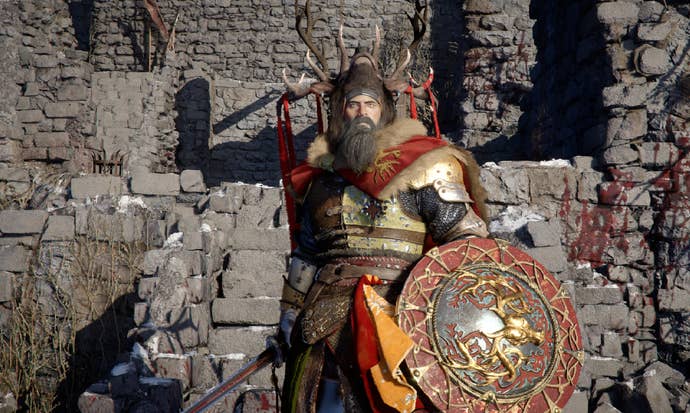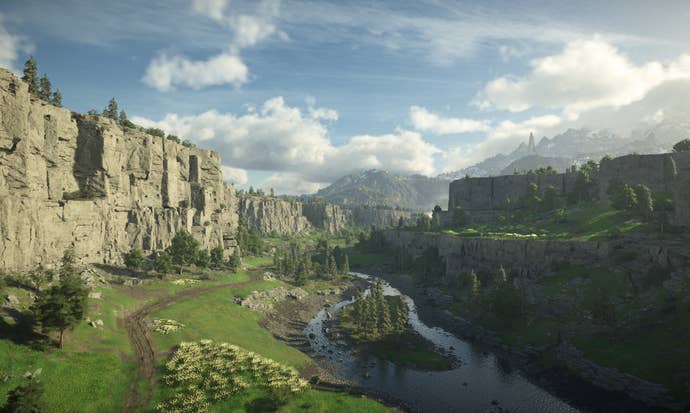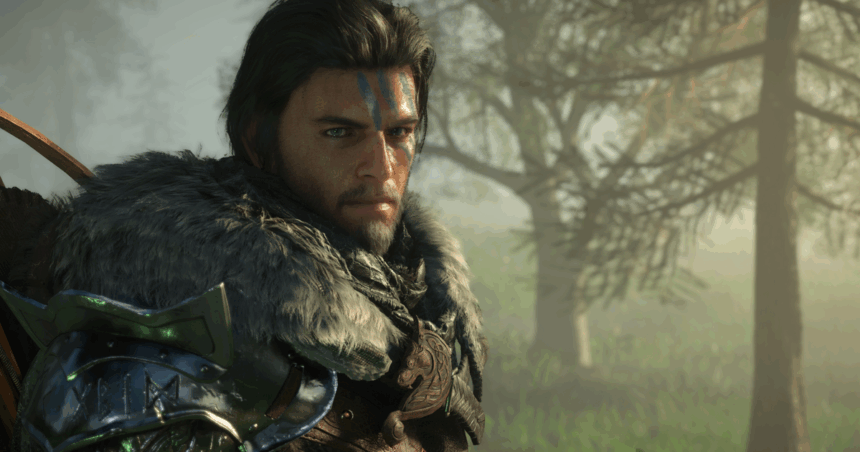Crimson Desert is beautiful. Black Myth: Wukong levels of beautiful. I remember being amazed at the details in Game Science’s game when I first saw it and Crimson Desert elicits a similar response.
The glistening sweaty limbs of a warrior in a fluffy bear skin cloak. The grand crumbling ruins of a castle, in which battle erupts in a flurry of particle effects. A spurt of crimson blood splashing on crisp snow. When I played it back at Gamescom last year, I was impressed by the game’s visuals despite squinting to see a relatively small screen.
However, I didn’t get on with the game’s combat at the time. And as the demo consisted solely of four boss fights, that’s all there was to it. More recently, I was offered a chance to play the game again and I was eager to see if it had been improved. After all, on paper this is my kind of game: full of adventure and challenging combat and some fantastical witchcraft. Unfortunately, even after a second go, my opinion hasn’t changed.
Crimson Desert, from Korean developer and publisher Pearl Abyss (best known for MMORPG Black Desert Online and forthcoming creature collector DokeV), is set in a detailed – if generic – medieval open world. Players take the role of the gruff-looking hero Kliff, defeating all manner of opponents from human soldiers to giant – or even colossal – beasts. Combat is tense and brutal: there’s thudding weight behind every sword swipe and defensive kick, but it revels in detail too. Over the course of each fight snow gradually covers gear, weapon clashes spark, and blood slowly stains each battlefield.
The demo began with a tutorial of sorts, in which our protagonist battles hordes of enemies as a nighttime camp is slowly consumed by fire. I was thrown straight in and, I confess, died immediately by getting booted off a cliff – probably a fitting end, honestly. That marked the beginning of my frustration. I managed to scrape through the rest of the tutorial practicing my shielding and parrying, before the demo cut to an ethereal void in which I could choose to take on four bosses in any order.
Crimson Desert is hard. It’s by no means a Soulslike, though feels inspired by that level of challenge. It’s hard because enemies are relentless and charge from all sides, because the odds are stacked against you, because the controls are fiddly. I just never found my rhythm.
The biggest boss of all, though, is the camera. Rather than being set close behind the protagonist as with most third-person games, it floats over the top and around, swooping down for cinematic moments, and clumsily fails to frame the action. What’s more, Pearl Abyss is clearly aiming for a visceral experience with Crimson Desert, as the camera shudders and shakes and spins with every punishing smack against Kliff. Yet it’s style over usability and too often had me spinning the camera to desperately see the action instead of the inside of a wall. Throw in sparks of weapon clashes, flames in the night, and myriad particle effects, and it’s a dizzying, disorientating experience.
The camera issues are further exacerbated by the lack of a proper lock-on. Shielding does target the nearest enemy, but the camera doesn’t adjust accordingly (something Ocarina of Time managed decades ago). Enemies don’t just surround you, they actively smack you from all sides and most of the time, thanks to the camera, that means they’re hiding off-screen. Instead of playing the hero by brutally punishing my enemies with elegant use of targeting, I ended up standing pathetically batting off attacks, spinning the camera in a hurricane twirl to seek out the next blow, and praying I was facing the right way to block properly. Most of the time, I was wrong.
As for the bosses, two were at least one-on-one fights: the first against the warrior Staglord whose leaps and thrusts had me backed up against the wall more often than I’d like; the second against the nippy Reed Devil who incessantly pummelled me while I tried to target magical totems with my bow. Both battles at least looked gorgeous, whether from swirling snowflakes or fluttering blades of grass. But I struggled to get to grips with the controls. Kliff has the standard light and heavy attacks, dodges, kicks, blocks and parries, but also a suite of special abilities accessed through the face buttons, a bow and arrow you can fire in the air (but takes an age to whip out), and a slow-motion effect you can trigger at any point by consuming energy. Then there are multiple weapon types and replenishing items awkwardly accessed through a weapon wheel on the d-pad. It’s a lot to take in for such a short preview and I’d hoped the basics would be enough to get by, but each boss proved a struggle.


The third boss was new for this demo: Hexe Marie, a magical witch summoning spawns of little warriors to chase Kliff around the courtyard. Again, the design was beautiful, but oh how I wished for a proper lock-on to flick between so many enemies. Instead I ignored the minions and did my best to target the witch alone, but here my attacks never seemed to connect with any weight. Frustrated, I ploughed on.
Eventually, three bosses defeated, I switched to the final encounter: the Queen Stoneback Crab. Taking an obvious cue from Shadow of the Colossus, this boss must be crawled over with specific weak points stabbed for a critical blow. Easy enough! But actually finishing the crab off – another beautiful design, by the way, with glowing crystals glinting on its back like rubies – required the use of a special item and awkward controls to then spin around the boss Spider-Man style before landing a killer blow. The timer ran out on me before I had a chance to try it.


All of this could just be personal preference. Maybe I’ve spent too much time playing Souls games that my expectations are skewed. But where so many action-focused games get it right – from Elden Ring, to Wukong, to Phantom Blade Zero, and beyond – Crimson Desert just felt wrong in my hands, its intricacies eluding me. Perhaps with time (and started slowly from the beginning) it could click, but after two goes I’m not convinced.
What’s more, Crimson Desert isn’t just combat but an open world adventure game. After the preview, Pearl Abyss provided footage of exploration and a world we could only glimpse outside boss arenas. As with those boss encounters, it’s certainly nice to look at and full of detail, but in all it lacks the grit and rough textures of The Witcher 3 or Kingdom Come Deliverance to match its spurts of blood. The world does at least hint at more magical goings on, with a mysterious alchemist and a white witch who bestow Kliff with strange powers.
As a result, Kliff leaps off a floating island and falls from the sky in a moment so audaciously stolen from Tears of the Kingdom you can only laugh. Later, he infiltrates enemy camps by sneaking around and assassinating soldiers in a manner similar to Assassin’s Creed. Throw in the aforementioned Shadow of the Colossus boss fight and, in all, I don’t think Crimson Desert has enough bold ideas of its own – it’s just another medieval open world fantasy with combat that left me cold. It’s brutal and bloody, but from what I’ve played and seen it’s not for me.

